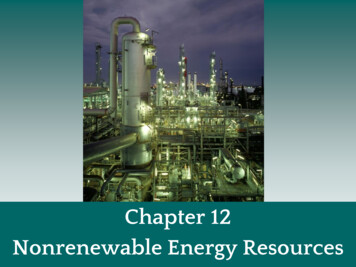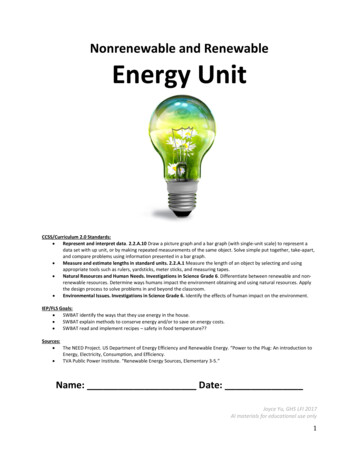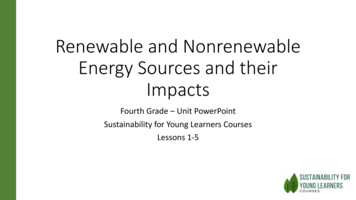
Transcription
Chapter 12Nonrenewable Energy Resources
Laws of thermodynamics1. Conservation of Energy which states energy is notcreated nor destroyed, it is conversed .transferredforms2. When energy is transformed, its ability to do work(force applied x distance in the direction of force)diminishes, some energy is “lost” during eachconversion (entropy) Energy is degraded (heat), as it moves up the trophiclevels converted into other forms of energy (totalenergy before total energy after) Energy is spontaneously regenerated by the sun we havematter on Earth that the sun gives energy (producers grow
Nonrenewable Energy Nonrenewable energy resources- substances thatonce used up, cannot be replenished (need to bereplaced, finite)2 types of nonrenewable resources:1. Fossil Fuels – derived from biological material that becamefossilized millions of years ago. Coal, Oil (Petroleum), Natural Gas – burned to harnessthe heat energy from combustion.2. Nuclear Fuels- derived from radioactive material that givesoff energy. Harness energy by transferring heat.
Peat, precursor tocoal, sometimescombined with coal,mostly in developingcountries.Coal, Oil, Natural gas are major sources of energy for the world
Energy Use Commercial energy sources- thosethat are bought and sold, such as coal,oil and natural gas. As nations become more developed .the demand forcommercial energy sources increases.Subsistence energy sources- thosegathered by individuals for their ownuse such as wood, charcoal and animalwaste.
Fossils fuels (such as coal) areprojected to rise due todeveloping nations (such asChina and India) increasing use
Process of Energy Use
Overall Fuel Efficiency ofU.S. Automobiles
Electricity Generation
Electricity Generation The burning fuel from coal transfers energyto water, which becomes steam.The kinetic energy contained within thesteam is transferred to the blades of aturbine, a large device that resembles a fan.As the energy in the steam turns theturbine, the shaft in the center of theturbine turns the generator.This mechanical motion generates energy. Potential to kinetic (generates electricity through the use of turbines)
Energy Efficiency (Singapore)Most coal burning power plants are about 35%efficient.
Cogeneration Cogeneration (combined heat and power)- usinga fuel to generate electricity and to produce heat.(using the steam generated as thermal energy) (Ex)- If steam is used for industrial purposes or to heatbuildings it is diverted to turn a turbine first.This improves the efficiency (not 100%) to as highas 90%, whereas steam heating alone is 75% andelectricity alone is 35%.We measure Energy efficiency by . both theefficiency of the process of obtaining the fuel andthe process that converts it into the work that isneeded (how we use it). Risk vs. Benefit
1. Coal Coal- a solid fuel formed primarily from theremains of trees, ferns, and other plant materials(ancient biomass) that were preserved 280-360million years ago. The efficiency of the transfer of energy from a fuel to electricity for acoal-fired power plant is approximately 35%These four types are: lignite, sub-bituminous,bituminous, and anthracite ranked from lesser togreater age, exposure to pressure, and energycontent. The largest coal reserves are in the United States,Russia, China, and India. Ideal fuel for stationary combustion applications,such as power plants, and industry
Liquified Coal (CTL) Coal liquefaction is a process of converting coal intoliquid hydrocarbons: liquid fuels and petrochemicals most common process chain is "Coal to Liquid Fuels"(CTL).Advantage: lower greenhouse emissions than regular coal, butmore than petroleumDisadvantage:large demand for water large demand for energy needed to process coal land degradation in the United States
CoalMaterial is buried under layers of sediment & exposed to heatand pressure, the organic compounds chemically transformedinto high-energy solid, liquid, & gaseous components that areeasily combusted
Advantages and Disadvantages of CoalAdvantagesEnergy-densePlentiful (abundant in U.S)Easy to exploit by surfaceminingTechnological demands aresmall (capabilities tomanufacture)Economic costs are lowEasy to handle and transportNeeds little refiningDisadvantagesContains impuritiesRelease impurities into air whenburnedTrace metals like mercury, lead,and arsenic are found in coalCombustion leads to increasedlevels of sulfur dioxide andother air pollutants into theatmosphere.Ash is left behindCarbon is released into theatmosphere which contributesto climate change
2. Petroleum Petroleum- a mixture of hydrocarbons, water, andsulfur that occurs in underground deposits.Oil and gasoline make this ideal for mobilecombustion, such as vehicles.Formed from the remains of ocean-dwellingphytoplankton that died 50-150 million years ago.Countries with the most petroleum are SaudiArabia, Russia, the United States, Iran, China,Canada, and Mexico. Ideal fuel for mobile combustion, vehicles.
PetroleumPetroleummigrates to thehighest point ina formation ofporous rock andaccumulatesthere. Liquidpetroleum(crude oil) canbe removed bydrilling a well.Refined intoasphalt,gasoline, diesel,kerosene
Advantages and Disadvantages ofPetroleumAdvantagesDisadvantagesConvenient to transport and use Releases carbon dioxide intoatmosphere (other pollutants, S,Hg, Pb, As like coal)Relatively energy-densePossibility of leaks whenextracted and transportedCleaner-burning than coalNot abundant in the U.S. (getfrom outside the states)Releases sulfur, mercury, lead, 85% of oil entering marineand arsenic into the atmosphere waterways come from runoff fromwhen burnedland, rivers, airplanes, boats, andaccidental spills (Killing birds andmarine life)
3. Natural Gas Natural gas- exists as a component of petroleum inthe ground as well as in gaseous deposits separatefrom petroleum (typically extracted withpetroleum).Contains 80 to 95 percent methane and 5 to 20percent ethane, propane, and butane.Largest uses of natural gas is electricity generationand industrial processes (24% of energy used in U.S) Be used as nitrogen fertilizer, residential efficient fuel (one-half U.Suses to heat homes)
Advantages and Disadvantages Natural GasAdvantagesDisadvantagesConsidered to be the “clean” fossil fuel When unburned, methane escapes intothe atmosphereContains fewer impurities andtherefore emits almost no sulfurdioxide or particulates (lower per unitenergy obtained)Emits only 60% as much carbondioxideas coalExploration of natural gas has thepotential of contaminatinggroundwater flow, causing areas toflood or wells to go dryDisturb soil (“thumper trucks”generating seismic vibrations in orderto identify natural gas deposits)Unburned natural gas-methaneProcess of drilling & opening up rock inescapes into the atmosphere is a potent order to release natural gas is calledgreenhouse gas that is 25x moreHydraulic Fracturing/Frackingefficient at absorbing Infrared energy (pipelines in sensitive areas) .largethan CO2qualities of water is used in this
Other Fossil Fuels Oil sands- slow-flowing, viscous deposits ofbitumen mixed with sand, water, and clay.Bitumen (tar or pitch)- a degraded type ofpetroleum that forms when a petroleum migratesclose to the surface, where bacteria metabolizesome of the light hydrocarbons and othersevaporate. (extracted by surface mining)Extend our oil supply, but much more energyintensive than conventional drilling for oil.***requires so much energy to refine, resulting CO2release greater.
The Hubbert Curve Hubbert curve- a graph that shows the point atwhich world oil production would reach amaximum and the point at which we would runout of oil. (reach a peak than steadily decrease)
The theory to the Futureof Fossil Fuel Use If current global use continues, we will run out ofconventional oil in less than 40 years.Coal supplies will last for at least 200 years, andprobably much longer.Advances in techn, a shift to non-fossil fuels,changes in social choices, and/or populationpatterns could alter the values above.
Nuclear Energy Same basic process as electricity generationfrom fossil fuels steam turns a turbine thatturns a generator that generates energy.Difference is that a nuclear power plant usesradioactive isotopes (uranium-235) as itsfuel source.Uranium-235 is a great fuel source due to itsability to conduct fission efficiency
Nuclear Energy Fission- anuclear reactionin which aneutron strikesa relatively largeatomic nucleus,which thensplits into twoor more parts.
Copyright 2000 by Houghton MifflinCompany. All rights reserved.*
Nuclear Reactors Fuel rods- the cylindrical tubes that house thenuclear fuel used in a nuclear power plant.Nuclear power plants work by using heat fromnuclear fission to heat water. This water producesthe steam to turn the turbine, which turns agenerator.Control rods- cylindrical devices that can beinserted between the fuel rods to absorb excessneutrons, thus slowing or stopping the fissionreaction .prevent meltdowns!!
Nuclear ReactorsLight-water reactor found in U.SControl rods – absorbs excess neutrons, slowing or stopping the fissionreaction (checks and balances)
Stream leads to turnthe turbine thatgenerates electricity(generator)Cooling water so thereactor core doesn’toverheat and have aCopyright 2000 by Houghton Mifflin“meltdown”Company. All rights reserved.*
Advantages and Disadvantagesof Nuclear EnergyAdvantagesNo air pollution is producedDisadvantagesPossibility of accidents(nuclear meltdowns –radiation released intoenvironment .Chernobyl)Countries can limit their need Disposal of the radioactivewaste (based on half life willfor imported oildetermine the disposalmethod). The longer the halflife, the longer it will take todecay
Radioactive Waste Radioactive waste- once the nuclear fuel cannot produce enough heat to be used in apower plant but it continues to emitradioactivity.This waste must be stored in special, highlysecure locations because of the danger toliving organisms.
Radioactive Waste High-level radioactive waste- the form used in fuel rods.Low-level radioactive waste- the protective clothing, tools,rags, and other items used in routine plant maintenance.Waste cannot be incinerated, safely destroyed using chemicals,shot into space, dumped on the ocean floor, or buried .becauseall these options can put damage our oceans and atmosphere.Waste should be stored in a geologically stable site away fromhumans habitation.On average, it takes a fuel rod at least 10 half-lives to decay inorder to reduce the threat on human healthOnly option is to store into something that doesn’t allow leachinginto our groundwater or otherwise escape into the environment.
Copyright 2000 by Houghton MifflinCompany. All rights reserved.*
Copyright 2000 by Houghton MifflinCompany. All rights reserved.*
Fusion Nuclear fusion- the reaction that powers the Sunand other stars. This occurs when lighter nucleiare forced together to produce heavier nuclei andheat is released.Fusion is a promising, unlimited source of energyin the future, but so far scientists have haddifficulty containing the heat that is produced.Trying to mimic the SUN
2 types of nonrenewable resources: 1. Fossil Fuels -derived from biological material that became fossilized millions of years ago. Coal, Oil (Petroleum), Natural Gas -burnedto harness the heat energy from combustion. 2. Nuclear Fuels-derived from radioactive material that gives off energy. Harness energy by transferringheat. Nonrenewable Energy










